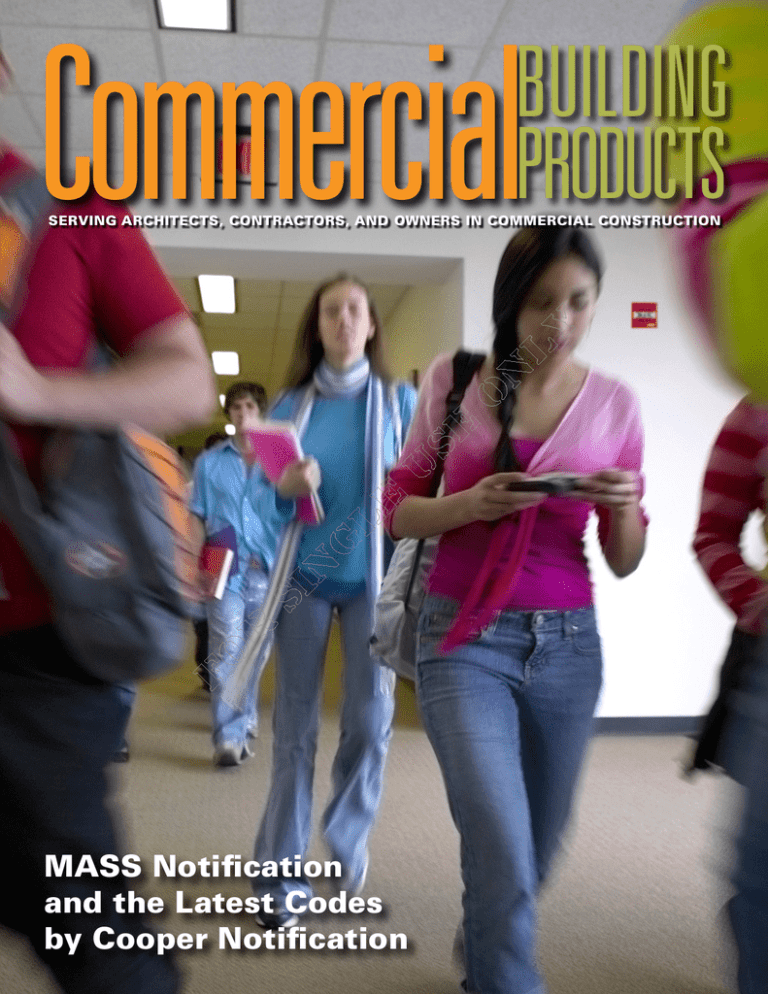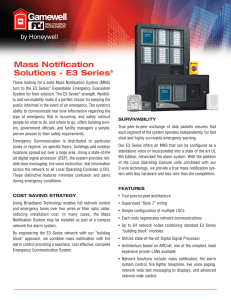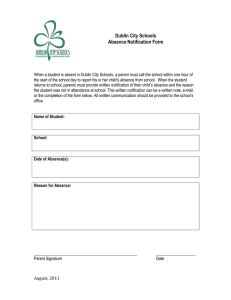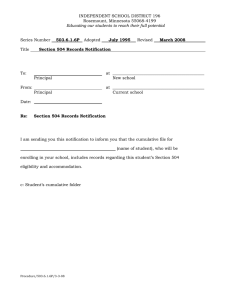
Commercial
BUILDING
PRODUCTS
SERVING ARCHITECTS, CONTRACTORS, AND OWNERS IN COMMERCIAL CONSTRUCTION
MASS Notification
and the Latest Codes
by Cooper Notification
feature security
Decoding
Mass
Notification
Codes
Fire codes apply
to more than fire
situations. A new
chapter takes up mass
notification systems
for the private sector.
Ted Milburn,
Cooper Notification
Mass notification systems need intelligible voice
commands to guide building occupants to a safe exit.
MNS Retrofit
Current fire alarm system
Sensors
MNS Solution - UL2572/NFPA 72 2010
Horns
Sensors
Horns
FIRE
FIRE
FIRE
FIRE
PULL
Pull Station
FIRE
PULL
FIRE
Pull Station
Strobes
FIRE
Addressable FACP
Strobes
Addressable FACP
Relocate strobe
circuit to MNS
Power Supply
ALERT
PS-8
MNS Strobes
Fire Alarm/
MNS Speaker
SPMNS manages all
audible and visual
notification appliances
SPMNS
Includes onboard
fire microphone
Strobes
Building owners can leverage existing infrastructure, systems, and equipment with minimal
upgrades and modifications. Illustration: Cooper Notification
T
oday’s facility managers are not only
concerned with protecting their facilities,
personnel, and community from sophisticated and complex threats, but also understanding and complying with the industry’s
latest codes and requirements. A new chapter
on mass notification systems is included in the
2010 edition of the National Fire Protection Association’s (NFPA), Quincy, MA, 72 National Fire
Alarm and Signaling Code.
The Dept. of Defense (DOD), Washington,
defines mass notification as a means to “provide
real-time information and instructions to people
in a building, area, site, or installation using
intelligible voice communications, along with
visible signals, text, and graphics, and possibly
including tactile or other communication
methods.” (See box on last page for a history
of mass notification systems.) The DOD further
states that mass notification systems (MNS)
“protect life by indicating the existence of an
emergency situation and instructing people of
the necessary and appropriate response and
action.”
In the 2010 code edition, Annex E became
“Chapter 24 Emergency Communications
Systems,” the first mass notification code for
the private sector. Underwriters Laboratories
has also moved toward establishing a new
standard for mass notification—UL 2572. It will
measure how a MNS performs against the NFPA
emergency communication systems’ (ECS)
codes.
Implementing MNS, step by step
While building owners may be overwhelmed by
the new codes, they should understand that they
can leverage their existing life-safety systems
with minimal upgrades and modifications.
Ensuring success doesn’t have to be a difficult
endeavor and can be accomplished by starting
with these steps:
1. Begin with a vulnerability and risk assessment.
2. Develop a master plan that integrates protection systems, mass notification systems, and
emergency-action plans.
3. Implement changes on a phased basis.
4. Leverage existing systems and equipment.
Completing a vulnerability and risk
assessment provides building owners a scope
of their current situation and allows them to
develop a master plan to address the needs of
the facility. It is highly recommended that these
master plans integrate protection systems, MNS,
and emergency-action plans.
Chapter 24 of NFPA 72 2010 is a
complete set of requirements for indoor
and outdoor emergency-communications
systems that consists of two classifications
of systems: one-way and two-way. One-way
communication systems include in-building
fire-emergency voice/alarm communications
systems, in-building MNS, wide-area MNS,
and distributed-recipient MNS (text messages,
voice calls, emails, pagers, and desktop
notification). For two-way communication
systems, the code recognizes two types: two-
Fire Alarm /MNS Solution
SYSTEM COMPONENTS
EXPANSION OPTIONS
Fire/MNS Speakers
SPB-160
Fire/MNS Speakers
SPB-320
SPMNS-MIC
SPMNS
Cluster Speaker
PS-8
FIRE
FIRE
FIRE
Fire
Strobes
Addressable FACP
ALERT
ALERT
ALERT
FIRE
FIRE
FIRE
MNS
Fire
Strobes
ALERT
ALERT
ALERT
MNS
PS-8
A mass notification system can manage all audible and visual notifications. Some systems feature a modular design that meets the functional
requirements of emergency-response plans. Illustration: Cooper Notification
way telephones and two-way in-building radio
communications.
An emergency-communications system
(ECS) must be installed where required by the
Authority Having Jurisdiction (AHJ) or other
applicable governing laws, codes, or standards.
Regardless of whether an ECS is required by the
AHJ or voluntary, installing a code-compliant
system ensures the facility owner that the
communications system has achieved a level of
performance tested to the rigorous standards of
the latest codes.
In-building MNS
In-building mass-notification systems are installed in buildings or structures for the purpose
of notifying and instructing occupants of an
emergency. An in-building MNS provides information and instructions using intelligible voice
communications and visible signals, text, graphics, tactile, or other communications methods.
Combining or integrating in-building
fire-emergency voice/alarm communications
systems with other communication systems
such as mass notification, public address, and
paging, is now allowed and encouraged by code.
Using one system that meets code is financially
beneficial to the owner since it reduces design,
installation, and on-going life-cycle costs. Firealarm or priority mass-notification messages
(as determined by a risk analysis) must take
precedence over any other announcement, such
as paging or public address.
In-building MNS components include:
primary control unit for the MNS, which monitors and controls notification appliances
• dedicated microphone for live emergencycommunication messages that can be distinguished from a fire microphone
• notification appliance circuit
• interface to a fire alarm system
• audible and visual notification devices.
•
The emergency response plan
Creating an emergency-response plan requires a
detailed risk analysis. When designing a massnotification system, consider the anticipated
risks of each facility, probability and frequency
of occurrence, and projected loss. How a facility
disseminates information and specific “takeaction” instructions needed for different types
of emergencies is an important element of risk
mitigation.
A facility’s emergency-response plan
(ERP) should be developed based on the risk
analysis and in accordance with NFPA 1600,
Standard on Disaster/Emergency Management
and Business Continuity Programs, and NFPA
1620, Recommended Practice for Pre-Incident
Planning. Plan elements include:
• team structure
• procedures for building system, human, terrorism, and weather emergencies
• equipment and operation
• notification (message content, approval, and
initiation processes)
•
training and drills.
An MNS provides live voice and prerecorded localized messaging within a protected
individual building, areas surrounding the
building, and other outdoor designated areas.
The notification zones are based on the risk
analysis. Each separate building should be
provided with a separate in-building MNS,
which must be designed with intelligible voice
in accordance with NFPA 72–2010 Chapter 18,
“Notification Appliances.”
An effective in-building MNS manages
all audio and visual notification appliances
and reports trouble and supervisory signals
through the fire-alarm system. Determined
by the ERP, the MNS control unit can
override the fire alarm with live voice from a
microphone or manual activation of a highpriority message. After the in-building massnotification system relinquishes control, the
fire-alarm system will automatically restore to
normal operation (without an active fire-alarm
signal) or operate based on the emergencyresponse plan with an active fire-alarm signal.
The priority level of recorded messages is
determined by the emergency-response plan and
based on an evaluation of:
• occupancy impact on individual security
• danger to life
• danger to community
• danger and impact on the nation.
Only recorded messages determined
by the ERP to be of higher priority than fire-
feature security
The Evolution Of
Mass Notification
I
n 1996, terrorists attacked Khobar Towers,
a U.S. Air Force housing complex in Dhah-
ran, Saudi Arabia, killing 19 U.S. servicemen
and wounding hundreds of others. Secretary
of Defense William Cohen issued a postincident report of the attack that concluded
there was no effective notification system
with which to warn personnel. The principal means for sounding an alarm at Khobar
Towers consisted of having personnel go
door-to-door throughout the eight-story
dormitory, alerting residents of the danger.
This primitive approach prompted the
U.S. military to develop force-protection
standards. Thus, in 1999, the U.S. Air Force
developed the Antiterrorism Force Protection Standards. To add to the standards, in
2002, the Dept. of Defense, Washington,
created the Unified Facilities Criteria (UFC)
4-010-01 Minimum Antiterrorism Standards
for Buildings, where mass notification was
first defined.
Two years later, the Defense Department published UFC 04-021-01 Design and
O&M: Mass Notification Systems, which
required the installation of intelligible voice
notification systems in and around new
“inhabited buildings.”
In creating the UFC, the Defense Department discovered that most fire-alarm
systems were unable to communicate with
people in non-fire emergencies such as
severe weather. The Air Force petitioned
NFPA to develop MNS requirements. As a
result, the NFPA added Annex E Mass Notification Systems as recommended guidelines for MNS in the National Fire Alarm
Code 2007 edition. This was the first time in
the history of the code that a non-fire-alarm
system could take precedence over a firealarm system. –Ted Milburn
alarm activation are permitted to override the
fire-alarm notification and initiate the mass
notification priority message. Activation of any
other recorded message must not interfere with
the operation of the fire-alarm system.
Signal priority is:
• discharge (fire suppression)
• MNS
• fire
• local microphone (higher priority than preprogrammed responses).
Using strobes for visible notification
Where there is audible notification, the inbuilding MNS must also provide visible notification in high-noise areas and to serve the hearing impaired. Typically, visible notification is
accomplished using clear strobes for fire alarm
and amber strobes for MNS. In addition to the
strobes, textual, graphic, or video displays can
also be used. Transmission of visible notification
and messages must be simultaneous to audible
notification and messages.
The wide-area MNS broadcasts real-time
intelligible voice messages, tones, and sirens
covering large outdoor areas. Wide-area MNS
can be used for applications such as campus
or facility giant-voice systems, public-warning
systems, and military base outdoor-notification
systems. System components include the
central control station and the high-power
speaker array (HPSA). The wide-area MNS must
be designed so that each notification zone
can be individually controlled by the central
control station. Intelligibility is in accordance
with the code, and minimum mounting heights
are based on the output of the speaker array
to prevent hearing damage. The HPSA must
have the capability to operate for a minimum of
seven days in standby, followed by 60 minutes
of operation at full load.
Although distributed-recipient, mass
notification systems (DRMNS) cannot be used in
place of the required audible and visible alerting
systems, DRMNS can be added and integrated
with these systems whenever possible for a multitiered communications system.
The DRMNS must be able to communicate
to hundreds or thousands of individuals through
multiple delivery methods, including mass-dialing
systems, emails, SMS/text messages, paging, and
desktop pop-up notifications. These Web-based
communication systems must be installed behind
appropriate Internet firewalls to protect the network
and be designed with a backup configuration to
facilitate distribution of messages.
solutions that enable them to leverage existing infrastructure, systems, and equipment with minimal
upgrades and modifications and still meet codes.
Cooper Notification, Long Branch, NJ,
designed the Safepath MNS to integrate with
a facility’s addressable fire-alarm system for a
complete MNS solution that performs fire-alarm
and emergency-communications functions.
Compliant with UL 2572 and NFPA 72 2010 codes,
the system provides personnel and building
occupants with intelligible live and pre-recorded
voice messages that communicate what to do in
response to an emergency. The system manages
all audible and visual notification and features a
modular and flexible design to meet the functional
requirements of emergency-response plans, as well
as the complexities of the new codes.
A system-of-systems approach
With a variety of MNS solutions available,
security professionals are recognizing the need
for a system-of-systems approach to emergency
communications. Instead of relying on just one
technology to do the job, multiple communication systems ensure that information will successfully reach the affected audience.
The system-of-systems approach to MNS
includes sending text messages and emails,
distributing automated voice calls, broadcasting
alerts over indoor or outdoor mass notification
systems, and using display signs, desktop alerts,
and social media. However, businesses are
realizing that launching alerts from multiple
communication systems can greatly increase the
time it takes to send and receive messages.
With limited staff and multiple
communication systems to employ, businesses
need an integrated emergency-notification
system with a simplified, single interface to
launch all of the different applications. This
allows facility managers and emergencyresponse personnel to focus on the emergency
at hand without being slowed down, trying to
activate multiple systems.
Today’s fire codes apply to more than fire
situations and affect a range of departments in
an organization. The key is looking for a solution
provider that has already decoded the latest
mass-notification codes and can help a building
owner put an effective building-communications
plan in place.
Ted Milburn is vice president of marketing
for Cooper Notification, Long Branch, NJ.
Code-compliant MNS solutions
It is important for building owners and facility
managers to not become inundated with these
codes. They need to understand how they can use
Website: www.coopernotification.com
Phone: 800.631.2148
Reprinted with permission from Commercial Building Products, July/August 2010. On the Web at www.cbpmagazine.com.
© COMMERCIAL BUILDING PRODUCTS. All Rights Reserved. Foster Printing Service: 866-879-9144, www.marketingreprints.com.



